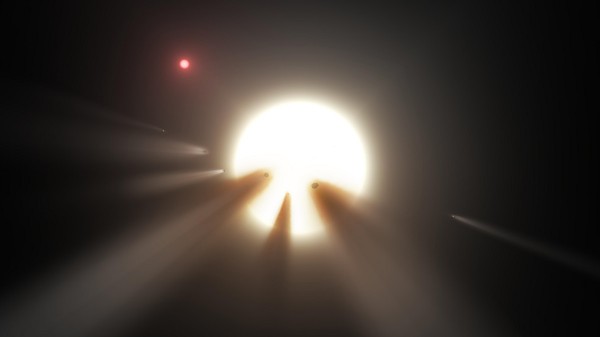By Ana Verayo, | January 15, 2017

This artist’s conception shows a star behind a shattered comet. (NASA/JPL-Caltech)
Astronomers may finally have the answer to why the mysterious, famous "alien megastructure star" (or Tabby's Star) is behaving like no other. Apparently, this star may have devoured an entire planet, causing its weird behavior.
Like Us on Facebook
This star, known as KIC 8462852, was first detected by the Kepler Space Telescope in 2015. Astronomers and scientists have also observed its erratic flickering in a random pattern.
Numerous theories have been put forward to explain its strange behavior such as a swarm of comets enshrouding a planet near the star or an alien megastructure blocking the star.
Natural causes such as this comet swarm or the fast spinning of a planet do not explain this odd case of KIC 8462852's dimming. In this new study, a team from the University of California, Berkley and Columbia University suggests that Tabby's star is suffering from "indigestion" after swallowing an entire planet.
Astronomers say that within the last 10,000 years, the star apparently devoured an entire planet and is now "burping" with its dimming.
By eating a planet, the star developed inflamed outer layers, making it shine brighter than usual. After this process, the star's outer corona is going back to normal and cooling again, and this ultimately explains this erratic flickering or dimming.
There are also remnants of this planet, and rocks and debris are swirling and falling into the surface of the star. This causes the star to flare up occasionally and reveal some shadows.
The team utilized different methods to determine planetary behavior within their orbits and applied them to KIC 8462852 along with the effects when a planet gets consumed by a star.
Their results revealed that this planet might have been the size of Jupiter or other lunar-sized bodies. It created a swarm of comets or asteroids at least a kilometer wide, blocking the star and resulted in this flickering and dimming rate.
This new study was published in the Monthly Notices of the Royal Astronomical Society.
-
Use of Coronavirus Pandemic Drones Raises Privacy Concerns: Drones Spread Fear, Local Officials Say

-
Coronavirus Hampers The Delivery Of Lockheed Martin F-35 Stealth Fighters For 2020

-
Instagram Speeds Up Plans to Add Account Memorialization Feature Due to COVID-19 Deaths

-
NASA: Perseverance Plans to Bring 'Mars Rock' to Earth in 2031

-
600 Dead And 3,000 In The Hospital as Iranians Believed Drinking High-Concentrations of Alcohol Can Cure The Coronavirus

-
600 Dead And 3,000 In The Hospital as Iranians Believed Drinking High-Concentrations of Alcohol Can Cure The Coronavirus

-
COVID-19: Doctors, Nurses Use Virtual Reality to Learn New Skills in Treating Coronavirus Patients







